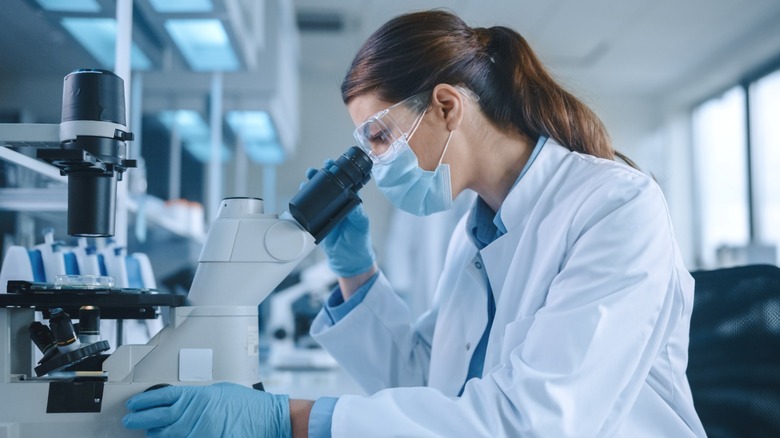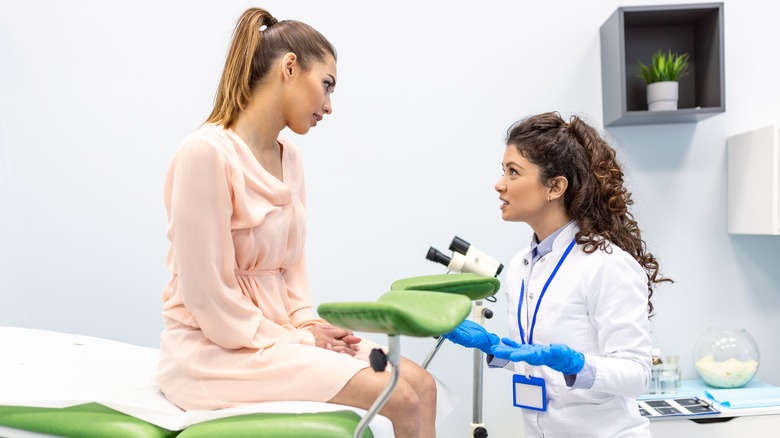What Are Precancerous Cells And How Serious Are They?
Hearing the words "precancerous cells" coming from your health practitioner's mouth can understandably set off some alarm bells. After all, cancer is the second leading cause of death in the United States, with the Centers for Disease Control and Prevention reporting that over 600,000 Americans died of cancer in 2020. Heart disease is the number one cause of death.
However, if you learn that you have precancerous cells, while this news understandably sounds scary, it does not mean that you're automatically predetermined to get cancer.
So, what exactly are precancerous cells then if they aren't indicative of some form of cancer?
Though precancerous cells are abnormal cells that differ in size and shape compared to normal cells, they are not yet cancerous. In fact, medical experts sometimes include precancer cells in the nonproliferative disease category. Examples of nonproliferative diseases include benign tumors, fibroids, and cysts, among other noncancerous growths. However, precancerous cells still have the potential to become cancerous down the road.
While precancerous cells are not the same as cancer cells, consider them a warning sign that cancer may develop in the future. Precancerous cells can contain mutations in their DNA, which could lead to uncontrolled growth and division, resulting in a malignant tumor. Health specialists typically discover precancerous cells, or precancerous lesions, during routine screenings or tests, such as a pap smear or colonoscopy. If you are getting regular screenings, oftentimes precancerous cells can be detected early enough to be addressed before they potentially evolve into cancer cells, according to the experts at City of Hope.
Dysplasia and precancerous cells explained
The term "dysplasia" is sometimes used interchangeably with "precancerous cells."
A broad term that describes a precancerous state that is more serious than hyperplasia — or the overgrowth of normal cells — dysplasia can affect many parts of the body, according to the experts at MedicalNewsToday.
The experts at Johns Hopkins Medicine report that cervical dysplasia, or abnormal cell growth along the surface of the cervix, occurs in at least 250,000 American women annually, mostly impacting those between the ages of 25 and 35. It is a precancerous condition that is sexually transmitted and caused by the human papillomavirus, more commonly known as HPV. Though the condition can sometimes resolve on its own or be treatable if caught early, cervical cancer is still a major cause of cancer deaths among women. While not all women who get HPV will develop cervical dysplasia, smoking, age factors, and a weakened immune system could potentially increase the risk, per Cleveland Clinic.
Another area of the body where dysplasia can develop is the colon. Doctors can detect if you have developed dysplasia in your colon through a stool culture, various types of colonoscopies, or a procedure called "flexible sigmoidoscopy," which involves a tube and a tiny flexible camera. Dysplasia may be low-grade or high-grade, depending on the level of abnormality of the cells. In both situations, the cells are still considered precancerous, but high-grade dysplasia may require more extreme measures beyond simply removing the precancerous cells to protect you against developing colon cancer, per Healthline.
Precancerous cells symptoms and treatments
One of the features of precancerous cells is that they, unfortunately, often have no symptoms, so you may not always realize you have them, especially when they are in areas not easily visible. However, depending on the location, there can sometimes be signs that you have an issue. For instance, Moffitt Cancer Center reports that if you see white spots in your mouth, these could be signs of the presence of precancerous cells, and abnormal uterine bleeding could be a sign that there is abnormal cell activity on the cervix (per Yale Medicine).
The good news is that there are various treatments to address precancerous cells, such as surgical removal, freezing the cells (cryotherapy), chemoprevention drugs, and topical medications. In some cases, lifestyle changes such as quitting smoking, maintaining a healthy diet, and regular exercise can also help reduce the risk of developing cancer.
While precancerous cells are not the same as cancer cells, consider them a warning sign that cancer may develop in the future. Precancerous cells can contain mutations in their DNA, which could lead to uncontrolled growth and division, resulting in a malignant tumor, according to "The Cell: A Molecular Approach" (via National Library of Medicine). This is why the early detection and treatment of precancerous cells are vital.
So talk to your doctor about any changes you notice in your body. Even if you don't have suspicious symptoms or haven't been diagnosed with precancerous cells, it's important to schedule regular check-ups and screenings to stay on top of your health to protect yourself from developing cancer in the future.


